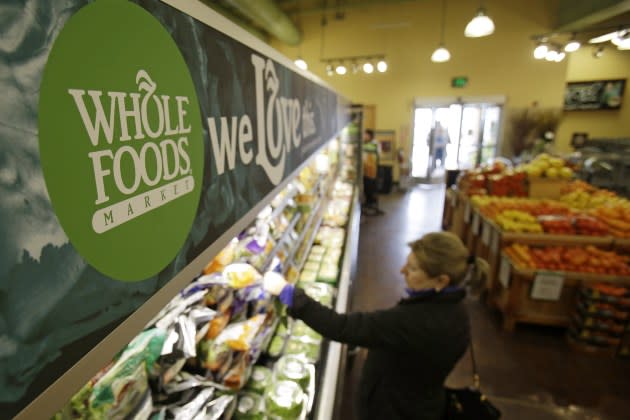Amazon Bringing Discounts, Prime to Whole Foods

Amazon isn’t wasting any time bringing its own retail style to Whole Foods.
The e-tailer said its $13.7 billion acquisition of Whole Foods is set to close on Monday and lower prices for grocery staples will be immediate, a move Amazon characterized as a “down payment” on a vision of making the grocer’s organic, high-quality offerings “affordable for everyone.”
More from WWD
Lower prices on more goods are imminent and the tech teams of Amazon and Whole Foods will also begin Monday to integrate Amazon’s Prime membership program into store sales systems, which will eventually allow members “special savings and in-store benefits.”
Further innovations aimed at merchandising, logistics and lowering prices are intended “over time,” Amazon said.
“This is just the beginning — we will make Amazon Prime the customer rewards program at Whole Foods Market and continuously lower prices as we invent together,” Jeff Wilke, chief executive officer of Amazon worldwide consumer, said. “There is significant work and opportunity ahead.”
“We can’t wait to start showing customers what’s possible when Whole Foods Market and Amazon innovate together,” John Mackey, Whole Foods cofounder and continuing ceo, said.
Certain Whole Foods stores will also be made home to Amazon’s locker service, which function as order delivery and return points for Amazon shoppers.
In addition to the changes in Whole Foods stores, the grocer’s in-store brands will be made available on Amazon and its shopping memberships AmazonFresh, Prime Pantry and Prime Now.
Outside of pricing and some operational shifts, Amazon said Whole Foods will continue operating under that brand name, remain headquartered in Austin, Texas, and maintain its support of local farmers and artisans, as well as its goal of offering natural and organic foods.
As for the notion that Amazon’s tech-savvy reputation would make for fewer grocery jobs, the company said Whole Foods will be adding employees and continuing to create jobs “as it opens new stores.”
Specifics on how many new stores there would be weren’t disclosed and an Amazon spokesperson could not be reached for comment.
The plan for swift changes comes little more than a day after Whole Foods shareholders voted in favor of the acquisition the same day the Federal Trade Commission ended its antitrust investigation of the deal, effectively giving it the green light to close.
Despite concerns by some politicians that the merger would depress grocery jobs and possibly wages, antitrust experts have seen the deal as a typical merger of little competitive concern in the space, namely because Amazon is not a major grocery player and gaining Whole Foods’ 400-plus stores won’t make it one.
But it will give Amazon a serious brick-and-mortar retail presence, giving it some momentum in its ongoing battle with Wal-Mart Stores, not to mention access to millions of new and loyal customers.
As for Whole Foods, the early moves by Amazon are aimed at turning around the struggling chain, which has faced challenges as rival food retailers — including Wal-Mart — have stepped up their natural and organic offerings. Whole Foods also continues to battle its image as an expensive — some critics say overpriced — food retailer that has been nicknamed by consumers “Whole Paycheck.” As part of Amazon, and hidden in the overall group’s financial accounts, Whole Foods can further slice what are already thin margins in food retailing in an attempt to gain market share.
For More, See:
Amazon Keeps Retail Push Rolling With ‘Instant Pickup’
Amazon Stock Bruised After Trump Says It’s Harming Retailers
Amazon Inks Violet Grey Deal: Sources
Best of WWD
